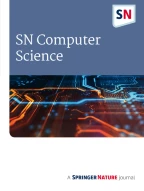Abstract
Research on reversible logic gained momentum in the past decade owing to its utility in emerging areas such as quantum computing, optical computing and low power circuit implementation, etc. Reversible circuits synthesized using existing techniques often tend to be sub-optimal; thus, post-synthesis optimization techniques are usually employed to reduce the ‘circuit cost’, a metric used to compare the reversible circuits. In this paper, a set of optimization techniques is proposed to minimize the circuit cost. These techniques rely on classifying a pair of reversible gates in a given circuit based on their structural similarity. An algorithm that maps the classifications with the optimization techniques to improve the cost of a circuit is also proposed. Results obtained for a set of benchmark reversible circuits confirm that the proposed methodology performs better in terms of circuit cost when compared to those available in the literature.
Similar content being viewed by others
References
Nielsen MA, Chuang IL. Quantum computation and quantum information. Cambridge: Cambridge University Press; 2010.
Cuykendall R, Andersen DR. Reversible optical computing circuits. Opt Lett. 1987;12(7):542–4.
Ciapurin I, Glebov L, Smirnov V. A scheme for efficient quantum computation with linear optics. Phys Rev Lett. 2001;86(22):51885191.
Gao W-B, et al. Experimental realization of a controlled-NOT gate with four-photon six-qubit cluster states. Phys Rev Lett. 2010;104(2):020501.
Landauer R. Irreversibility and heat generation in the computing process. IBM J Res Dev. 1961;5(3):183–91. https://doi.org/10.1147/rd.53.0183.
Bennett CH. Logical reversibility of computation. IBM J Res Dev. 1973;17(6):525–32.
Wille R, Drechsler R, Osewold C, Garcia-Ortiz A. Automatic design of low-power encoders using reversible circuit synthesis. In: DATE ’12, 1036–1041 (EDA Consortium, San Jose, CA, USA, 2012). https://doi.org/10.5555/2492708.2492966.
Saeedi M, Markov IL. Synthesis and optimization of reversible circuits—a survey. ACM Comput Surveys (CSUR). 2013;45(2):21.
Wille R, Drechsler R. Towards a design flow for reversible logic. Berlin: Springer Science & Business Media; 2010.
Maslov D, Dueck GW, Miller DM. Techniques for the synthesis of reversible Toffoli networks. ACM Trans Des Autom Electron Syst. 2007. https://doi.org/10.1145/1278349.1278355.
Arabzadeh M, Saeedi M, Zamani MS. Rule-based optimization of reversible circuits. In: 15th Asia and South Pacific Design Automation Conference (ASP-DAC), IEEE Press;2010. p. 849–54. https://doi.org/10.1109/ASPDAC.2010.5419684.
Datta K, Sengupta I, Rahaman H. A post-synthesis optimization technique for reversible circuits exploiting negative control lines. IEEE Trans Comput. 2015;64(4):1208–14.
Datta, K. et al. Exploiting negative control lines in the optimization of reversible circuits. In: RC’13, 209–220 (Springer-Verlag, Berlin, Heidelberg, 2013). https://doi.org/10.1007/978-3-642-38986-3.
Miller DM, Wille R, Drechsler R. Reducing reversible circuit cost by adding lines. In: 40th IEEE International Symposium on Multiple-Valued Logic (ISMVL), IEEE Press; 2010. p. 217–22. https://doi.org/10.1109/ISMVL.2010.48.
Wille R, Soeken M, Drechsler R. Reducing the number of lines in reversible circuits. In: Design Automation Conference, IEEE Press; 2010. p. 647–52. https://doi.org/10.1145/1837274.1837439.
Rice J, Fazel K, Thornton M, Kent K. Toffoli gate cascade generation using ESOP minimization and QMDD-based swapping. In: Proceedings of the Reed-Muller Workshop (RM2009), 2009; p. 63–72.
Bandyopadhyay C, Rahaman H, Drechsler R. Improved cube list based cube pairing approach for synthesis of ESOP based reversible logic. In: Gavrilova, Marina L. et al., editors. Lecture Notes in Computer Science, Vol. 8911. Springer Berlin Heidelberg; 2014, p. 129–46.
Datta K, Gokhale A, Sengupta I, Rahaman H. An ESOP-based reversible circuit synthesis flow using simulated annealing. In: R. Chaki et al., editors. Advances in Intelligent Systems and Computing, Vol. 305. Springer India; 2015, p. 131–44.
Nayeem NM, Rice JE. A shared-cube approach to ESOP-based synthesis of reversible logic. Facta Univ-Ser Electron Energet. 2011;24(3):385–402.
Soeken M, Roetteler M, Wiebe N, De Micheli G. Hierarchical reversible logic synthesis using LUTs. In: 54th ACM/EDAC/IEEE Design Automation Conference (DAC),IEEE Press; 2017. p. 1–6. https://doi.org/10.1145/3061639.3062261.
Fazel K, Thornton M, Rice J. ESOP-based Toffoli gate cascade generation. In: IEEE Pacific Rim Conference on Communications, Computers and Signal Processing. IEEE Press; 2007. p. 206–9. https://doi.org/10.1109/PACRIM.2007.4313212
Meuli G, Soeken M, Roetteler M, Wiebe N, De Micheli G. A best-fit mapping algorithm to facilitate ESOP-decomposition in Clifford+T quantum network synthesis. In: 23rd Asia and South Pacific Design Automation Conference (ASP-DAC), IEEE Press; 2018. p. 664–9. https://doi.org/10.1109/ASPDAC.2018.8297398.
Meuli G, Schmitt B, Ehlers R, Riener H, De Micheli G. Evaluating ESOP optimization methods in quantum compilation flows. Cham: Springer International Publishing; 2019. p. 191–206.
Toffoli T. Reversible computing. Berlin: Springer; 1980.
Barenco A, et al. Elementary gates for quantum computation. Phys Rev A. 1995;52(5):3457.
Wille R, Grosse D, Teuber L, Dueck G, Drechsler R. RevLib: an online resource for reversible functions and reversible circuits. In: 38th International Symposium on Multiple Valued Logic (ISMVL), IEEE Press; 2008. p. 220–5. https://doi.org/10.1109/ISMVL.2008.43.
Maslov D, Dueck GW, Miller DM. Toffoli network synthesis with templates. IEEE Trans Comput Aided Des Integr Circ Syst. 2005;24(6):807–17. https://doi.org/10.1109/TCAD.2005.847911.
Soeken M, Thomsen MK, Dueck GW, Miller DM. White dots do matter: rewriting reversible logic circuits. In: Dueck GW, Miller DM, editors. Reversible computation. Berlin: Springer Berlin Heidelberg; 2013. p. 196–208.
Wille R, Soeken M, Otterstedt C, Drechsler R. Improving the mapping of reversible circuits to quantum circuits using multiple target lines. In: 18th Asia and South Pacific Design Automation Conference (ASP-DAC), IEEE Press; 2013. p. 145–50. https://doi.org/10.1109/ASPDAC.2013.6509587.
Drechsler R, Finder A, Wille R. Improving ESOP-based synthesis of reversible logic using evolutionary algorithms. In: C. Di. Chio et al., editors. Lecture Notes in Computer Science,Vol. 6625. Springer Berlin Heidelberg; 2011, p. 151–61.
Author information
Authors and Affiliations
Corresponding author
Ethics declarations
Conflict of interest
The authors declare that they have no conflict of interest.
Additional information
Publisher's Note
Springer Nature remains neutral with regard to jurisdictional claims in published maps and institutional affiliations.
This article is part of the topical collection “Hardware for AI, Machine Learning and Emerging Electronic Systems” guest edited by Himanshu Thapliyal, Saraju Mohanty and VS Kanchana Bhaaskaran.
Rights and permissions
About this article
Cite this article
Sai Phaneendra, P., Vudadha, C. & Srinivas, M.B. Optimization of Reversible Circuits Using Gate Pair Classification. SN COMPUT. SCI. 3, 40 (2022). https://doi.org/10.1007/s42979-021-00900-5
Received:
Accepted:
Published:
DOI: https://doi.org/10.1007/s42979-021-00900-5
